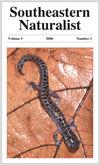乔治亚州斯图尔特堡长叶松生境的盗蝇(双翅目:盗蝇科)
IF 0.4
4区 环境科学与生态学
Q4 BIODIVERSITY CONSERVATION
引用次数: 0
摘要
摘要/ Abstract摘要:在美国乔治亚州东南部沿海平原的斯图尔特堡(Fort Stewart),研究了2种不同的长叶松(Pinus palustris)栖息地类型(mesic Pine flatwoods,干性沙丘)的盗蝇(Asilidae)区系。从2020年10月至2022年11月,我们在111个日期的30个站点进行了空中网和扫网调查。我们还采样了硬木和松木-硬木混合群落。共采集盗蝇380只,分25属62种。在长叶松生境中共记录到47种,其中旱生长叶松沙地采集到42种,中生长叶松平原林采集到20种。在硬木生境中发现32种。在5个地点发现了一种鲜为人知的地鼠(Gopherus polyphemus)洞穴的专性共生动物。我们从干旱长叶松沙丘中记录的两个物种,马基姆斯·布兰托尼和艾菲里亚·洛索纳,代表了佐治亚州的第一个州记录。在仲子松平原林中发现的台湾棘足虫种群表明其分布范围有明显的扩展。此外,我们还首次报道了来自乔治亚州的腹式腹腹弓形虫。本文章由计算机程序翻译,如有差异,请以英文原文为准。
The Robber Flies (Diptera: Asilidae) of Longleaf Pine Habitats on Fort Stewart, Georgia
Abstract - We inventoried the robber fly (Family Asilidae) fauna of 2 distinct Pinus palustris (Longleaf Pine) habitat types (mesic pine flatwoods, xeric sandhills) on a large, fire-managed landscape (Fort Stewart) located in the Coastal Plain of southeastern Georgia. We conducted aerial-net and sweep-net surveys at 30 sites on 111 dates from October 2020 to November 2022. We also sampled hardwood and mixed pine–hardwood communities. We collected a total of 380 robber flies comprising 25 genera and 62 species. We recorded 47 species from Longleaf Pine habitats, with 42 species collected from xeric Longleaf Pine sandhills and 20 species from mesic Longleaf Pine flatwoods. Thirty-two species were found in hardwood habitats. Machimus polyphemi, a poorly known obligate commensal of Gopherus polyphemus (Gopher Tortoise) burrows, was found at 5 sites. Two species that we documented from xeric Longleaf Pine sandhills, Machimus blantoni and Efferia slossonae, represent the first state records for Georgia. An Echthodopa cf. formosa population found in mesic pine flatwoods represents a significant range extension. Also, we report Stichopogon abdominalis from Georgia for the first time.
求助全文
通过发布文献求助,成功后即可免费获取论文全文。
去求助
来源期刊

Southeastern Naturalist
环境科学-生态学
CiteScore
1.20
自引率
16.70%
发文量
31
审稿时长
18-36 weeks
期刊介绍:
The Southeastern Naturalist covers all aspects of the natural history sciences of terrestrial, freshwater, and marine organisms and the environments of the southeastern portion of North America, roughly bounded from North Carolina south to Florida, west to Texas, north to Oklahoma, and east back to North Carolina. Manuscripts based on field studies outside of this region that provide information on species within this region may be considered at the Editor’s discretion.
 求助内容:
求助内容: 应助结果提醒方式:
应助结果提醒方式:


